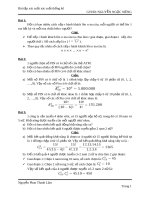Bài tập xác suất thống kê
Bạn đang xem bản rút gọn của tài liệu. Xem và tải ngay bản đầy đủ của tài liệu tại đây (75.25 KB, 2 trang )
Exam
Probability and Statistics
Bernardo Guimaraes
September 2007
1. (9 pts) A researcher collected 100 observations on a random variable X and calculated the mean
and the median. He obtained M ean(X) = 10 and M edian(X) = 8. Subsequently, he realized
that the highest observation in his sample was misreported. He had x1 = 20, but the correct value
was x1 = 21.
(a) Using the correct value of x1 , what is the mean of X? If it can’t be calculated, explain why.
(b) Using the correct value of x1 , what is the median of X? If it can’t be calculated, explain
why.
(c) What do the values of M ean(X) and M edian(X) hint about asymmetry?
2. (7 pts) Let X and Y be random variables with joint probability density function
fX,Y (x, y) = 2
for 0 ≤ x ≤ 1, 0 ≤ y ≤ 1 and 0 ≤ x + y ≤ 1. Are X and Y independent? Explain.
3. (11 pts) X and Y are independent random variables, with marginal density functions:
x
, 0≤x≤2
2
fY (y) = 1 , 0 ≤ y ≤ 1
fX (x) =
Find the joint cumulative distribution function for all possible values of x and y.
4. (9 pts) A supermarket has 2 express lines. Let X and Y denote the number of customers in the
first and the second, respectively, at a given time. Denote by pX,Y (x, y) the joint probability
function of X and Y .
(a) Would you expect X and Y to be independent?
(b) Would you expect pX,Y (x, y) to be symmetric, that is, would you expect pX,Y (a, b) =
pX,Y (b, a)?
(c) Would you expect pX,Y (5, 2) to be bigger than pX,Y (2, 2)? Or bigger than pX,Y (5, 5)?
5. (7 pts) Let X and Y be random variables such that Y = 2X + 2. The probability density function
of X is:
fX (x) = 1 , 0 ≤ x ≤ 1
What is the probability density function of Y ?
6. (10 pts) Consider the random variable Y , such that Pr(Y = 1) = θ, and Pr(Y = 0) = 1 − θ.
A sample consisting of n independent realizations of Y ({y1 , y2 , ..., yn }) was collected. Find the
method of moments estimator of θ.
1
7. (11 pts) Consider the random variable X, such that Pr(X = x) = (1 − p)x−1 p, for x = 1, 2, ....
A sample consisting of n independent realizations of X ({x1 , x2 , ..., xn }) was collected. Find the
maximum likelihood estimator of p.
8. (11 pts) The time between eruptions of a given volcano, T , follows an exponential distribution,
with hazard rate λ (see formulas below). A researcher wants to test whether λ < 5, with level of
significance 5%. For that, he has only one observation, t.
(a) What are the null and alternative hypotheses?
(b) What are the values of t that lead the researcher to reject the null hypothesis?
9. (12 pts) X is a random variable described by an exponential distribution.
A researcher collected a sample consisting of 81 independent realizations of X ({x1 , x2 , ..., x81 }).
She found that:
81
81
X
X
xi = 6480 and
(xi − x
¯)2 = 6480
i=1
i=1
where x
¯ is the sample mean. To simplify calculations, note that 6480 = 80 × 81.
Find a confidence interval for the mean of the distribution (µ) with 95% confidence.
10. (13 pts) Consider a normal random variable with unknown mean µ and variance σ 2 = 4. A
researcher wants to test whether µ is greater than 0.
(a) What are the null and alternative hypotheses?
(b) At 5% level of significance, what should be the size of the sample if the researcher wants to
reject the null hypothesis with probability 90% if µ = 1?
__________________________________
• You can apply the Central Limit Theorem for n > 30.
√
√
√
• For calculations, you can use: 2 = 1.4, 3 = 1.7 and 5 = 2.2.
• Exponential distribution (hazard rate λ):
— Probability density function: f (t) = λe−λt .
— Cumulative distribution function: f (t) = 1 − e−λt .
— Expected value: µ =
1
λ
• Normal distribution:
— Probability density function: f (x) =
1 x−µ
√ 1 e− 2 ( σ )
2πσ
2
2
.









